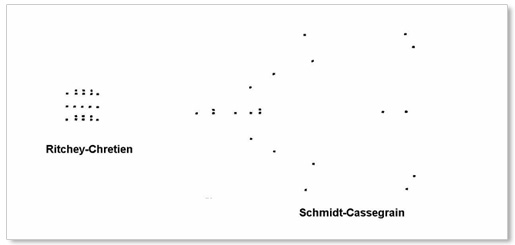RITCHEY-CHRETIEN
OPTICS
PROFESSIONAL SERIES
Specifications
for standard design optics follow.
|
RITCHEY-
CHRETIEN |
PRIMARY
FOCAL LENGTH |
BACK
FOCUS |
SPACING
|
SECONDARY |
PRIMARY
HOLE |
|
|
|
|
|
|
|
RC-12P |
12.5"
f 9 |
40" |
12" |
26.5" |
4.80" |
3.5" |
RC-14P |
14.25”
f 8 |
40” |
13” |
26.4” |
5.50” |
3.50” |
RC-16P |
16"
f 8.4 |
48" |
14" |
31.7" |
6.00" |
4" |
RC-20P |
20" f 8.1
|
60" |
15" |
39.7" |
7.60" |
4.5" |
RC-24P |
24"
f 8 |
72" |
16" |
48.2" |
9.00"
|
5.5" |
| NOTE:
Additional sizes and focal lengths can be manufactured
on a custom basis.
Please contact us for information. |
WHY
IS STAR INSTRUMENTS' RITCHEY-CHRETIEN DESIGN
SUPERIOR TO PRODUCTION-TYPE SCHMIDT-CASSEGRAIN SYSTEMS?
Below
are spot diagrams for a 12.5" f9 Ritchey-Chretien
versus an 11" f10
Schmidt-Cassegrain with an f2 primary and 5x secondary.This
spot diagram would be comparable to all production Schmidt-Cassegrains.
(1/2 degree off axis)

As
you can see, the Ritchey-Chretien
is several times better than the Schmidt-Cassegrain.
There are several reasons for this:
• The lower the amplification factor
of the secondary mirror, the flatter the field.
• The Ritchey-Chretien system has a 2.7x secondary, whereas
the Schmidt-Cassegrain has a 5x
secondary.
• Ritchey-Chretien is coma-free, whereas Schmidt-Cassegrain
is not. Production-type Schmidt Cassegrains use a spherical
primary and secondary which do not correct for coma.
Ritchey-Chretien has a hyperbolic primary and a hyperbolic
secondary which correct coma.
• Ritchey-Chretien only has two surfaces; Schmidt-Cassegrain
has four. Therefore,
Ritchey-Chretien has less light loss.
OPTICAL FABRICATION
STAR
INSTRUMENTS optics are of the highest quality and figured
in our own facility by experienced opticians using modern
equipment. Computerized polishing machines have been
developed to improve optical quality of larger telescope
mirror systems. Professional series optics are fabricated from Russian
AstroSitall, which is a zero expansion glass, or
upon request, Schott Zerodur, Corning ULE or Fused Silica.
Pyrex is not a zero or low expansion glass and the homogeneous
properties of the glass are not consistent enough to
allow us to make high quality optics. Primary mirrors are fabricated using lightweight
dish-type blanks or full thickness on request. Completed optical systems are supplied
without coatings.
OPTICAL TESTING
STAR INSTRUMENTS uses optical flats up to 41" in
diameter to test in autocollimation all optics to insure
excellent performance. A Zygo interferometer and software
is used to provide hardcopy interferometric
test data that is supplied with each set of completed
optics. Back
focus and spacing information is etched on the primary
mirror, and the Star Instruments Job Number is etched
on both the primary and secondary mirrors.
OPTICAL QUALITY
STAR INSTRUMENTS guarantees a minimum of 1/4 wave front,
1/20 wave r.m.s. on all systems.
STAR INSTRUMENTS continues to be concerned with the
false advertising claims being made by amateur optical
suppliers who claim 1/10 to 1/20 wave optics. These
claims tend to confuse the amateur astronomer into believing
you must have 1/10 wave optics, when in reality there
are very few 1/4 wave 8" and larger optical systems.
The fact is that Pyrex is not a zero expansion glass
and, therefore, cannot keep a figure better than 1/4
wave front.



